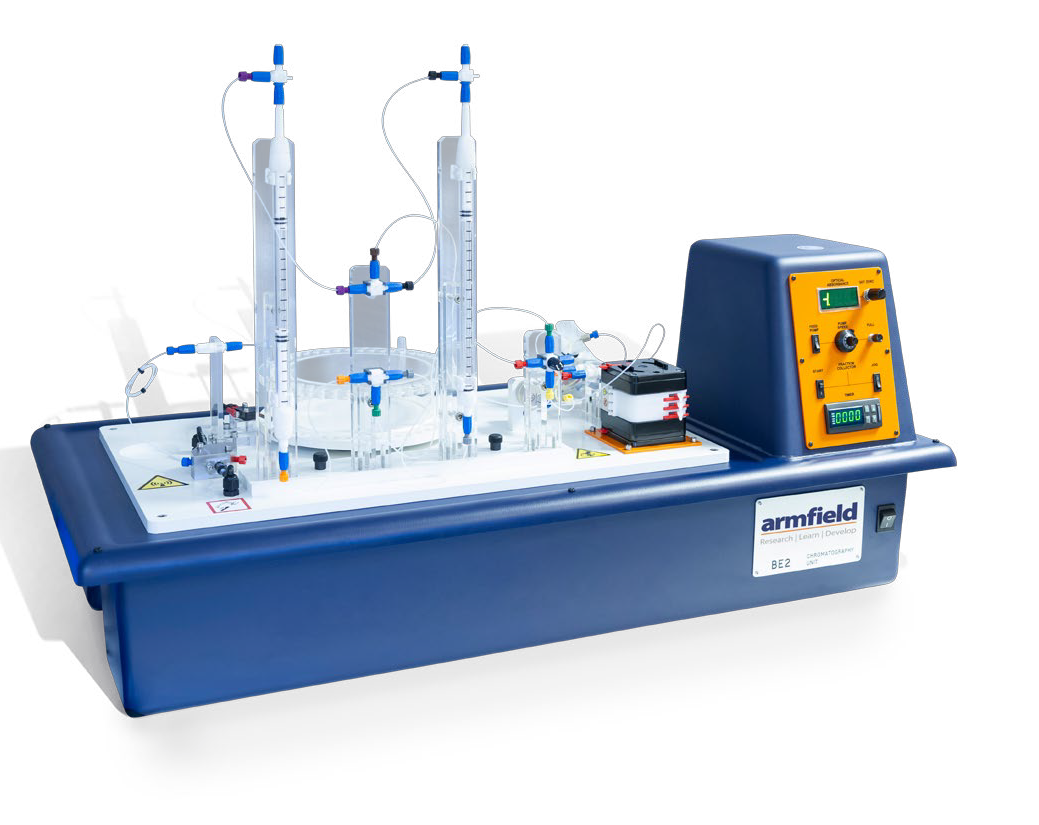Description
The BE2 consists of a benchtop unit onto which are mounted two 250mm long,10mm diameter borosilicate glass chromatography columns. Both are equipped
with adjustable end pieces to enable different bed heights to be investigated.
On the top of each column are septum injectors to enable introduction of a sample onto the column surface. The columns are fed by a three-channel
peristaltic pump of an eight-roller design in order to give smooth flow. The pump has a variable-speed drive and a wide range of tube bores can be used,
thus giving a very wide flow rate range.
Switching valves enable the operator to easily select the desired column for operation. A bubble trap is fitted before the inlet to the columns to prevent air
from entering. The outlet from the column passes to a UV optical flow cell for measurement of sample elution. Liquid exiting the flow cell can either be led
to drain or collected using the fraction collector, this is timer controlled and has capacity for forty eight 3ml test tubes.
It is essential that all buffers and samples introduced to the column are filtered and degassed in order to protect the column. Equipment required for this is standard
laboratory equipment, these are available as an option (BE2-1) if required.
BE2-1 consists of a membrane filter holder, vacuum flask, water vacuum pump and membrane filters. The sample filtration system consists of a syringe and
disposable membrane filters. Sample injection syringes and needles are also included.
The methods required for liquid chromatography do take some practice in order to achieve reproducible results. Therefore, for users with no experience in
this area it is recommended that training is supplied.
The BE2 Chromatography Unit demonstrates an industrially important type of chromatography, low-pressure liquid chromatography. Several varieties can be
demonstrated by the BE2, including ion-exchange, size-exclusion, hydrophobic interaction and affinity chromatography. Each of these types uses a different
method of separation, which are particle charge, particle size and shape, molecule hydrophobicity and biological specificity, respectively.
The BE2 system includes detailed experimental procedures for size-exclusion chromatography, particularly in relation to the separation of proteins and dyes.
However, it may also be used to investigate other types of low-pressure liquid chromatography.
Size-exclusion chromatography uses porous beads to separate particles of different sizes. The size range of the pores in the beads defines whether
particles are totally excluded, partially excluded or whether they have full entry into all beads. Particles that are totally excluded have the shortest residence
time in the column, whereas particles that have full entry into the beads have the longest residence time. Partially excluded particles have residence times
between the two. On this basis particles of different sizes are separated.
Overall dimensions
Length
1.10m
Width
0.50m
Height
0.70m
Packed and crated shipping specifcations
Volume
0.44m3
Gross weight
36Kg

 Enquiry:hkmarketing@epc.com.hk
Enquiry:hkmarketing@epc.com.hk 











